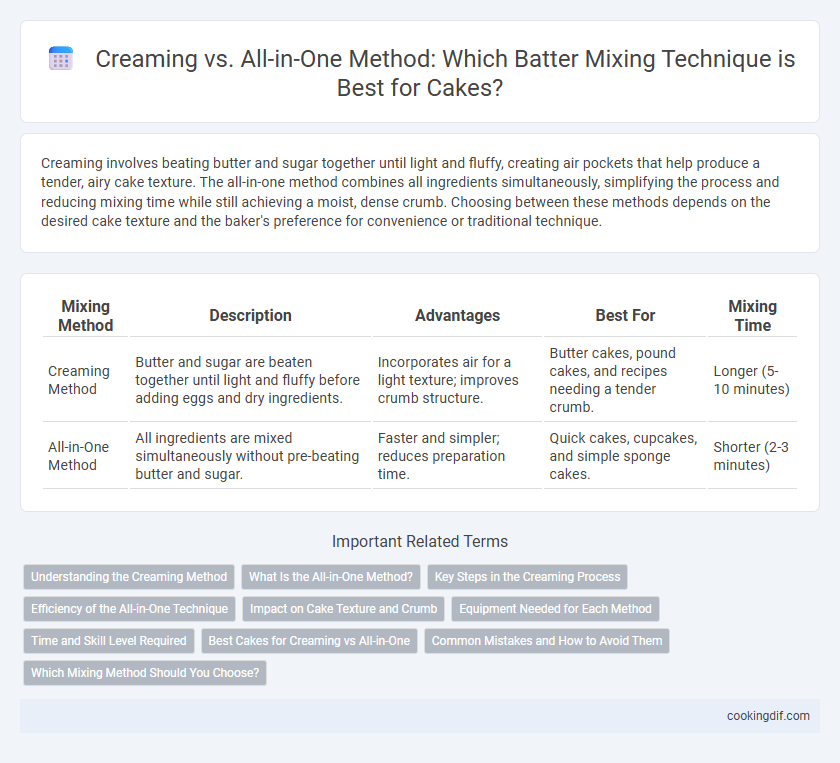Creaming involves beating butter and sugar together until light and fluffy, creating air pockets that help produce a tender, airy cake texture. The all-in-one method combines all ingredients simultaneously, simplifying the process and reducing mixing time while still achieving a moist, dense crumb. Choosing between these methods depends on the desired cake texture and the baker's preference for convenience or traditional technique.
Table of Comparison
| Mixing Method | Description | Advantages | Best For | Mixing Time |
|---|---|---|---|---|
| Creaming Method | Butter and sugar are beaten together until light and fluffy before adding eggs and dry ingredients. | Incorporates air for a light texture; improves crumb structure. | Butter cakes, pound cakes, and recipes needing a tender crumb. | Longer (5-10 minutes) |
| All-in-One Method | All ingredients are mixed simultaneously without pre-beating butter and sugar. | Faster and simpler; reduces preparation time. | Quick cakes, cupcakes, and simple sponge cakes. | Shorter (2-3 minutes) |
Understanding the Creaming Method
The creaming method involves beating butter and sugar together until light and fluffy, which incorporates air to help the cake rise and create a tender crumb. This technique is ideal for butter-based cakes like pound cakes and layer cakes because it produces a fine, uniform texture. Understanding the precise timing and speed during creaming is crucial to avoid overmixing, which can result in a dense or tough cake.
What Is the All-in-One Method?
The all-in-one method involves combining all the cake batter ingredients--flour, sugar, butter, eggs, and leavening agents--simultaneously in a single mixing step, streamlining preparation and reducing mixing time. This technique promotes even distribution of ingredients, resulting in a tender crumb and consistent texture in cakes. Unlike the creaming method, it requires less skill and equipment, making it ideal for quick homemade or commercial cake production.
Key Steps in the Creaming Process
The creaming method for cake batter involves beating softened butter and sugar together until the mixture becomes light and fluffy, which incorporates air to help the cake rise. Key steps include gradually adding sugar to the butter while mixing at medium speed, ensuring the mixture is pale and increases in volume. This process creates a stable matrix that traps air bubbles, resulting in a tender, evenly textured crumb.
Efficiency of the All-in-One Technique
The all-in-one method streamlines the cake batter preparation by combining all ingredients at once, significantly reducing mixing time compared to the traditional creaming method. This technique minimizes steps and equipment use, enhancing overall kitchen efficiency without compromising texture and rise. Bakers benefit from a faster process that maintains consistent results, ideal for large batches or time-sensitive baking projects.
Impact on Cake Texture and Crumb
The creaming method aerates the batter by beating butter and sugar together, resulting in a light, tender crumb with a fine, even texture. The all-in-one method mixes ingredients simultaneously, producing a denser cake with a more compact crumb due to less incorporated air. Choosing creaming over all-in-one significantly affects cake volume and softness, making it ideal for sponge cakes and layered desserts.
Equipment Needed for Each Method
The creaming method requires an electric mixer or a stand mixer with a paddle attachment to effectively beat butter and sugar until light and fluffy, ensuring proper aeration. In contrast, the all-in-one method can be done with a simple hand whisk or spoon since all ingredients are combined simultaneously, making it a quicker and less equipment-intensive process. Both methods may utilize baking bowls, measuring tools, and spatulas, but the creaming technique's reliance on powered mixers is crucial for achieving the desired texture.
Time and Skill Level Required
The creaming method demands more time and skill, as it requires beating butter and sugar until fluffy for proper aeration, ensuring a tender crumb. The all-in-one method is faster and simpler, combining all ingredients simultaneously, making it ideal for beginners or quick recipes. Efficiency in mixing impacts cake texture, with creaming offering finer crumb structure compared to the denser result from the all-in-one technique.
Best Cakes for Creaming vs All-in-One
Creaming method is ideal for butter cakes and pound cakes, as it incorporates air into the mixture, resulting in a light, tender crumb with fine texture. The all-in-one method suits sponge cakes and simple chocolate cakes, offering quick preparation and a uniformly moist result due to combined mixing of ingredients. Choosing the right method depends on the desired cake density and crumb structure, with creaming favored for rich, fluffy cakes and all-in-one for moist, evenly textured cakes.
Common Mistakes and How to Avoid Them
Common mistakes in creaming include overworking the butter and sugar, which can lead to a dense cake texture; to avoid this, beat until light and fluffy but not greasy. In the all-in-one method, failing to properly in incorporate ingredients can cause uneven texture or lumps; use room-temperature ingredients and mix thoroughly but gently. Ensuring accurate ingredient measurement and avoiding overmixing are key to achieving a tender, evenly textured cake with either method.
Which Mixing Method Should You Choose?
The creaming method, which involves beating butter and sugar until light and fluffy, produces a tender and airy cake texture ideal for butter-based recipes. The all-in-one method combines all ingredients simultaneously for a quicker, simpler process, best suited for denser, spongier cakes like some pound cakes and cupcakes. Choose the creaming method for light, moist cakes with fine crumb structure, and the all-in-one method when time efficiency and ease are priorities without sacrificing basic texture quality.
Creaming vs All-in-one Method for Mixing Batter Infographic

 cookingdif.com
cookingdif.com